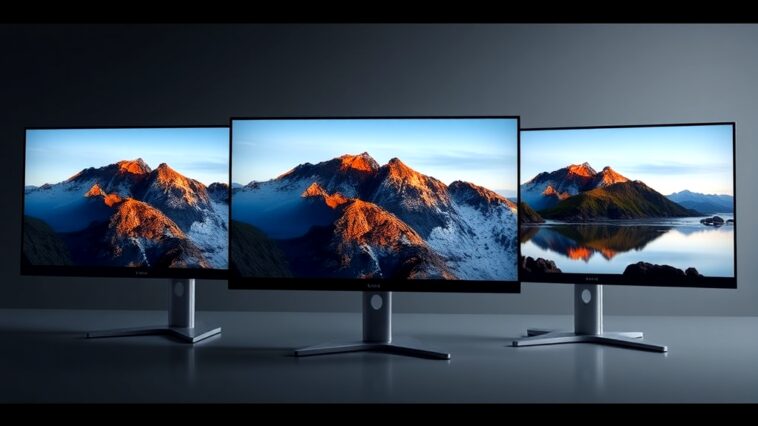Are you on the hunt for the perfect HDR monitor? With so many choices out there, it’s easy to feel overwhelmed. But don’t worry! We’re here to break it down for you. In this guide, we’ll explore the best HDR monitors available in 2025, what to look for, and how to avoid common pitfalls like “fake HDR” displays. Let’s jump in and make your search easier and more engaging!
The Best HDR Monitors (2025 Reviews)
Quick Summary
| Monitor | Size | Resolution | Key Features | Price |
|---|---|---|---|---|
| AOC Q27G3XMN | 27″ | 1440p | High peak brightness, 336 mini LED dimming zones, VRR up to 180FPS | $300 |
| Xiaomi G Pro 27i | 27″ | 1440p | IPS panel, 1152 dimming zones, 97% Adobe RGB coverage | $X |
| AOC AG274QZM | 27″ | 1440p | 240Hz refresh rate, 576 dimming zones, USB-C | $X |
| Innocn 27M2V | 27″ | 4K | 99% DCI-P3, 1000-nit peak brightness, VRR up to 144FPS | $X |
| Samsung Neo G7 | 32″ | 4K | 1196 dimming zones, 1000-nit peak brightness | $X |
| Innocn 32M2V | 32″ | 4K | 99% Adobe RGB, 1152 dimming zones, USB-C | $X |
| BenQ EX321UX | 32″ | 4K | 99% DCI-P3, 1152 dimming zones, ergonomic stand | $X |
| Samsung G95NA | 49″ | 5120×1440 | 2048 dimming zones, FreeSync Premium Pro | $X |
What is HDR and Why Does It Matter?
Understanding HDR
HDR stands for High Dynamic Range. It’s a technology that enhances the visual experience by allowing displays to show a wider range of colors and brightness levels. Traditional monitors often struggle to display bright highlights and dark shadows simultaneously. HDR monitors, on the other hand, shine in this area, providing richer colors and improved contrast.
The Importance of True HDR
When shopping for an HDR monitor, you’ll often encounter terms like “fake HDR” or “pseudo-HDR.” These terms can be alarming, but they highlight a significant issue in the market. Many manufacturers slap an HDR label on their products without providing the essential features for true HDR performance.
Real-World Impact: Imagine watching a movie where the dark scenes look murky because the monitor can’t handle the contrast. You want a monitor that can display those stunning bright highlights without losing detail in the shadows. That’s where true HDR comes into play!
Key Features to Look For in HDR Monitors
When searching for your perfect HDR monitor, there are essential features that you should focus on:
1. Panel Type
- OLED vs. LED: OLED panels provide superior contrast and vibrant colors because they can turn off individual pixels completely, creating true blacks. However, they come with risks like burn-in and can be more expensive. LED panels, particularly those with Full Array Local Dimming (FALD), can also deliver great HDR but may not reach the same contrast levels as OLED.
2. Brightness Levels
- Peak Brightness: Look for monitors that can achieve at least 1000 nits of peak brightness for HDR content. Higher brightness levels mean more vivid highlights and a more immersive experience.
Real-World Impact: Picture yourself playing a game with stunning graphics. The brighter the highlights, the more captivating the environment will be!
3. Color Gamut
- Wide Color Gamut: A good HDR monitor should cover a wide color spectrum, ideally 99% of DCI-P3 or better. This ensures that the colors displayed are more vibrant and true to life.
4. Local Dimming Features
- Full Array Local Dimming (FALD): This feature allows for better control of backlighting, which is crucial for producing bright highlights while maintaining deep blacks. Monitors with edge-lit dimming often fall short in providing a true HDR experience.
5. Resolution and Refresh Rate
- Resolution: While 4K is becoming the standard for HDR, 1440p monitors can still deliver great performance for gaming without the hefty GPU requirements.
- Refresh Rate: Higher refresh rates (like 144Hz or above) can enhance the smoothness of gameplay, especially in fast-paced games. Look for monitors that support Variable Refresh Rate (VRR) technologies like FreeSync or G-SYNC.
The Best HDR Monitors of 2025
Let’s take a look at some of the top HDR monitors available this year. We’ve categorized them based on various features to help you find the one that suits your needs best!
Best Mini LED HDR Monitors
1. AOC Q27G3XMN
- Size: 27 inches
- Resolution: 1440p
- Panel Type: VA
- Brightness: Up to 1200 nits
- Local Dimming: Yes (336 zones)
Pros: High peak brightness, decent pixel density, excellent features for gamers.
Cons: Minor blooming noticeable in certain scenes.
2. Xiaomi G Pro 27i
- Size: 27 inches
- Resolution: 1440p
- Panel Type: IPS
- Brightness: High peak brightness
- Local Dimming: Yes (1152 zones)
Pros: Wider color gamut, quick response time, great for color-critical work.
Cons: Lower native contrast ratio compared to VA panels.
Best UltraWide HDR Monitors
3. Innocn 34M1R
- Size: 34 inches
- Resolution: 3440×1440
- Panel Type: VA
- Brightness: 1000 nits
- Local Dimming: Yes (2304 zones)
Pros: High contrast ratio, vibrant colors, immersive curved design.
Cons: Minor ghosting behind fast-moving objects.
Best 4K HDR Monitors
4. Innocn 27M2V
- Size: 27 inches
- Resolution: 4K UHD
- Panel Type: IPS
- Brightness: 1000 nits
- Local Dimming: Yes (1152 zones)
Pros: Sharp details, great for gaming and professional work.
Cons: Higher demand on GPU for 4K gaming.
5. Samsung Neo G7
- Size: 32 inches
- Resolution: 4K UHD
- Panel Type: Mini LED
- Brightness: Up to 1200 nits
- Local Dimming: Yes (1196 zones)
Pros: Excellent gaming performance, vibrant colors, ergonomic design.
Cons: Some blooming artifacts in demanding scenes.
Best Budget HDR Monitors
6. AOC AG274QZM
- Size: 27 inches
- Resolution: 1440p
- Panel Type: Mini LED
- Brightness: High peak brightness
- Local Dimming: Yes (576 zones)
Pros: Affordable, solid HDR performance, good gaming features.
Cons: Fewer local dimming zones than pricier models.
Avoiding the Pitfalls of HDR Monitors
Recognizing Fake HDR
When shopping for HDR monitors, beware of products that claim to support HDR but lack the necessary features. Here are a few red flags:
- Low Peak Brightness: Monitors that can’t reach at least 600 nits are likely not delivering a true HDR experience.
- No Local Dimming: Monitors without FALD or other local dimming technologies will struggle with contrast and may not provide the depth of color you’re looking for.
- Poor Color Coverage: Monitors that cover less than 90% DCI-P3 may not deliver vibrant colors and a rich visual experience.
Conclusion
Finding the perfect HDR monitor doesn’t have to be a daunting task. By focusing on key features like panel type, brightness, color gamut, and local dimming capabilities, you can make an informed decision that suits your needs—be it for gaming, professional work, or casual use.
So, what are you waiting for? Dive into the world of HDR monitors, and you’ll be amazed at how much more vibrant and enjoyable your visual experiences can be. Happy shopping!
Feel free to adjust any part of this to better fit your specific audience or content goals!




